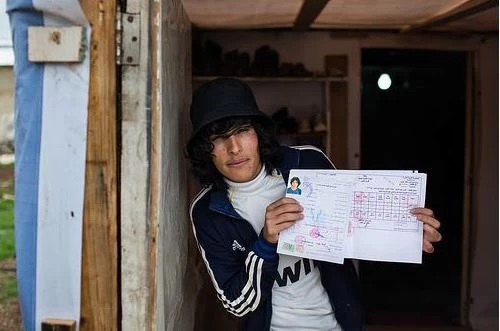Also available in: Español

– his high school diploma certificates.
"These are my life, they are my future.
I left everything behind in Syria, but not these."
Pre-war, 93% of Syria’s children attended schools and some 25% of eligible youth attended tertiary institutions. But well over half of Syria’s youth in higher education are estimated to be displaced, unable to pursue their education due to insecurity or because their university facilities have been destroyed and their faculty scattered. There may be 200,000 “higher education qualified” Syrian students among the 12 million population of displaced.
Until the massive Syrian crisis hit, agencies dealing with refugees and the internally displaced focused on emergency humanitarian assistance, providing food, sanitation, shelter and basic education for rudimentary skill building, literacy and some primary schooling. Historically, this derives from long-established distinctions between humanitarian intervention and development programs. Nowadays, however, agencies like the UNHCR and others are ramping up their support to higher education.
Indeed, if Syria and the region are to recover from the violence and extremism of the past four years, the international community needs to find mechanisms to open paths to education for Syrians. Aside from radicalization, there is also the danger that members of a whole generation, mostly from the Sunni majority, will be marginalized as they focus on their day-to-day survival, losing the skills and discipline needed to succeed academically and professionally.
Prior to the war, higher education in Syria was already plagued by a lack of investment and a stifling atmosphere, especially when it came to politics. Still, there had been reforms, starting in 2000 and addressing quality, and the growth of new elite private universities alongside the large public universities in Damascus and Aleppo. Over 100,000 students attended university, with more students in technical academies that are roughly equivalent of community colleges. Education in engineering, medicine and architecture compared favorably with other Arab countries. Universities were co-educational and women constituted over half of students. University students, largely middle class, were among the first Syrians to protest against their government in 2011, paying the price once the harsh government response was unleashed.
Jordan and Lebanon together have some 40,000–50,000 potential Syrian university students. But they have challenges, such as qualifications that are missing or incomplete, and incompatibilities of national education systems that impact everything from high school graduation to university transfers. These challenges include getting documents and funds from Syria and the often hostile attitude of Syrian embassies and consulates. Especially in Lebanon, lacking English or French is a major issue. The complex relationship between Lebanon and Syria can present Syrian students with problems, too.
Another barrier is fees putting many institutions of higher learning out of reach for Syrian students. Less than 10% of eligible Syrian students are enrolled in either Jordan or Lebanon, with the overwhelming majority men—women, once the majority in Syrian universities, are now a small minority. Egypt, previously a favored destination for Syrian students, has become much less welcoming since the Egyptian regime changed in July 2103. Before, Syrians were allowed to register much like locals did for undergraduate programs, though with extra fees involved. With 14,500 Syrian undergraduates out of a total Syrian refugee population of 133,000, Egypt still has the region’s largest number of Syrian undergraduates. But new arrivals are rare.
Although Turkey’s linguistic barrier looms large for Syrian students, they have the right to enroll in Turkish universities providing they can prove language proficiency. They do not have to pay fees, and UNICEF and local universities have a few initiatives to teach Turkish. Issues of documentation do arise, but select universities near the border can dispense with documents and accept Syrians as “special students”, though implementation has been spotty. There are political sensitivities, though, as perceptions of university slots going to refugees can lead to tensions.
As of the 2014-2015 academic year, there were some 4,600 Syrian students enrolled in Turkish universities. The private sector has stepped in with a proposal to set up a university for Syrians, and Turkey and Qatar will jointly establish an Arabic and English language university for Syrian refugees that aims to employ the 400 Syrian academics in Turkey.
Many of the Syrians seeking refuge in Europe are middle class and include university students. Europe and the developed world in general does not want for scholarships. These help hundreds of people every year but the scale now requires interventions of a different magnitude. Europe also wants to know whether these students will ever return, raising the need to consider rebuilding Syrian universities in secure parts of Syria.
There is an urgent need to bundle assistance to displaced university students together with other humanitarian assistance, but this is an area with few previous examples. Organizations and bodies like the European Union are only beginning to understand the challenges involved. With a whole generation of Syrians displaced and unable to continue their studies, the very future of Syria hangs in the balance. Without effective outreach to these young Syrians, the future of Syria may look even bleaker than today.


Join the Conversation